 klaus-michael schneider
klaus-michael schneider
Keywords: colombia |
Links: FOTW homepage | search | disclaimer and copyright | write us | mirrors

Last modified: 2021-08-26 by  klaus-michael schneider
klaus-michael schneider
Keywords: colombia |
Links: FOTW homepage |
search |
disclaimer and copyright |
write us |
mirrors
Pre-Military Schools:
See also:
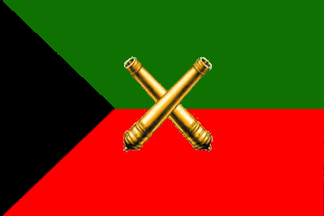 image by Ivan Sache, 30 December 2020
image by Ivan Sache, 30 December 2020
Academia Militar General Gil Colorado, located in Tuluá (Valle del Cauca), is
named for Major General Carlos Julio Gil Colorado, Commander of the 4th Division
of the Army, who was ambushed and killed by the FARC guerilla on 19 July 1992, a
few km from Villavicencio.
https://www.eltiempo.com/archivo/documento/MAM-177186
El Tiempo, 20 July
1994
The flag of Academia Militar General Gil Colorado is horizontally
divided green-red with a black triangle placed along the hoist and charged in
the center by two yellow cannons crossed per saltire.
Green represents
the beauty of the natural environment and the abundance of fields, which convey
hope, peace and harmony.
Red represents the life of the martyrs who offered
their lives for a better security, tranquility and a promising future for the
country.
Black, the emblematic color of Artillery in the Colombian Armed
Forces, is a symbol of pain and mourning of the motherland, which has suffered
in times of hope, peace and harmony, and in periods of struggle for tranquility
and security deserved to a nation.
The crossed cannons in the flag's center
refer to the Colombian Artillery. Since its early origin in the times of the
Patriotic Army, the Colombian Artillery has been evolving and has adapted to
technological advances to form a very efficient support to assault troops,
especially infantrymen.
https://www.academiamilitargeneralgilcolorado.edu.co/home/simbolos-institucionales/
School website
Ivan Sache, 30 December 2020
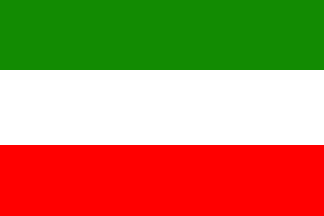 image by Ivan Sache, 30 December 2020
image by Ivan Sache, 30 December 2020
Academia Militar General Gustavo Rojas Pinilla (AMGRP) was established in
2002 in Montería (Córdoba), as Academia General Gustavo Rojas Pinilla. The
school was granted the status of pre-military school by Resolution No. 1,716
issued on 29 March 2010 by the Ministry of Defense, as well as the name of
Academia Militar General Gustavo Rojas Pinilla.
The school is named for
General Gustavo Rojas Pinilla (1900-1975), President of the Republic of Colombia
from 1953 to 1957.
https://academiamilgrp.edu.co/
AMGRP website
The flag of AMGRP is horizontally divided green-white-red.
Green
represents the fertility of the valleys of Sinú and San Jorge, cradle of the
cattle-breeding resources of the region.
White represents the leadership of
the region for white gold (cotton) and is the symbol of peace.
Red represents
the blood shed by the martyrs who offered their lives all along the history.
https://academiamilgrp.edu.co/institucion/simbolos-institucionales/
AMGDP website
Photo
https://mapio.net/pic/p-5355600/
Ivan Sache, 30 December 2020
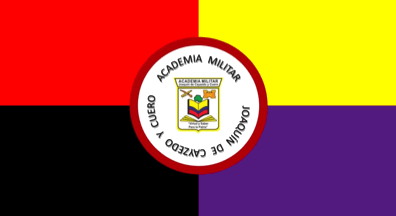 image by Ivan Sache, 30 December 2020
image by Ivan Sache, 30 December 2020
Academia Militar Joaquín de Cayzedo y Cuero was established in 1982 in Cali
(Valle del Cauca) by Major Víctor Manuel Cañas Trujillo (1934-2019).
The
school is named for Alférez Real Joaquín de Cayzedo y Cuero (1773-1813), then
one the highest representatives of the Spanish crown in South America. On 3 July
1810, acting as the President of the Extraordinary Government of Cali, Cayzedo
required more autonomy (not independence yet) and direct administration of the
territory. He subsequently presided the Confederation of the Towns of Valle del
Cauca in 1811-1812 and led the civil war against Miguel Tacón, Governor of
Popayán.
https://acamilcayzedo.edu.co/
School website
The
flag of Academia Militar Joaquín de Cayzedo y Cuero, designed in 1982 by its
founder, is quartered red-yellow-black-purple with the school's emblem in the
center.
The quarters honor the main components of the Colombian Army: Red for
Infantry, yellow for Cavalry, black for Artillery, and purple for Engineers.
https://acamilcayzedo.edu.co/bandera-escudo-himno/
School website
Ivan Sache, 30 December 2020
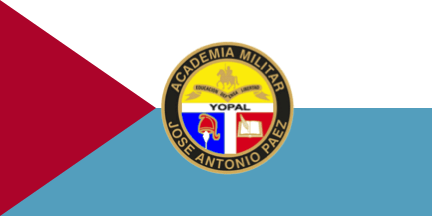 image by Ivan Sache, 30 December 2020
image by Ivan Sache, 30 December 2020
Academia Militar José Antonio Paéz was established on 16 November 2007 in
Yopal (Casanare).
The school is named for José Antonio Paéz (1790-1873), the
father of the independence of Venezuela from Gran Colombia, President of
Venezuela from 1830 to 1835, 1839 to 1843, and 1861 to 1863.
The flag of
Academia Militar José Antonio Paéz is horizontally divided white-celestial blue
with a red triangle placed along the hoist.
The red triangle symbolizes the
blood shed by the local members of the liberation army.
White is a symbol of
mind purity and virtues to be practiced by the cadets.
Celestial blue
symbolizes the greatness of the sky and of the seas.
https://academiamilitaryopal.edu.co/simbolos
School website
The
flag in actual use is charged with the school's coat of arms.
Photos
https://www.facebook.com/acamilyopal/photos/2897889207160632
https://www.facebook.com/acamilyopal/photos/2565253417090881
https://www.facebook.com/acamilyopal/photos/2521256728157217
https://www.facebook.com/acamilyopal/photos/2439603452989212
https://www.facebook.com/acamilyopal/photos/2387643068185251
https://www.facebook.com/acamilyopal/photos/2292413101041582
The
upper field, covering one half of the shield, features on a yellow background
the "indomitable centaur", representing the defense of the Colombian nation.
Beneath it, a scroll inscribed with the school's motto "EDUCACIÓN - DEFENSA -
LIBERTAD" (Education - Defense - Liberty).
The lower left quarter features on a blue
background a liberty cap.
The lower right quarter features on a red
background a white book and quill, as symbols of education.
https://academiamilitaryopal.edu.co/simbolos
School website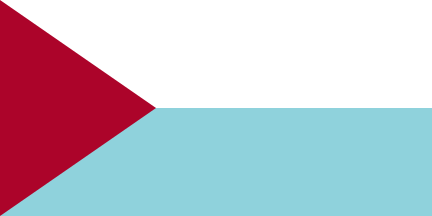 image by Ivan Sache, 30 December 2020
image by Ivan Sache, 30 December 2020
In a less official context,
the flag was used without the coat of arms.
Photo
https://www.facebook.com/acamilyopal/photos/2415642562051968
Ivan Sache, 30 December 2020
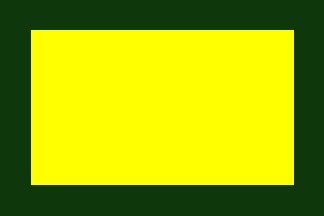 image by Ivan Sache, 30 December 2020
image by Ivan Sache, 30 December 2020
Academia Militar Mariscal Sucre was established on 13 February 1978 in
borough Ricaurte, Bogotá, by Captain Jorge Jaimes Contreras, Lieutenant Aníbal
Gómez Pico, Lieutenant Antonio Gamboa Carrero, and (civilian) Jesús Poveda
Arias. The school is owned by EDACMIL Ltd., a company established by the
families of the four founders.
The school operates two campuses, in Ricaurte
(central seat; 600 students), and Suba (rural seat inaugurated in 1986; 1,500
students).
The flag of Academia Militar Mariscal Sucre is yellow with a
dark green border.
Ivan Sache, 30 December 2020
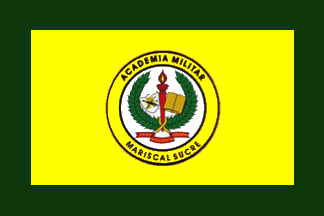 image by Ivan Sache, 30 December 2020
image by Ivan Sache, 30 December 2020
The flag is also used with the school's emblem in the center.
https://docplayer.es/109748369-Antonio-gamboa-carrero-gustavo-jaimes-j-director-general-academico.html
Proyecto Educativo Institucional, 2015
Ivan Sache, 30 December 2020
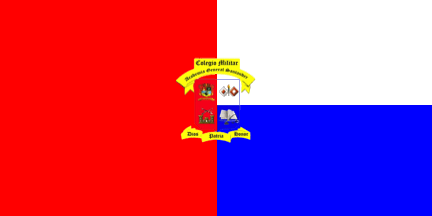 image by Ivan Sache, 30 December 2020
image by Ivan Sache, 30 December 2020
Colegio Militar Academia General Santander was re-founded on 1 January 2009
in Facatativá (Cundinamarca) by the brothers Carlos Alberto and Ricardo
Contreras Peña, two retired officers of the Colombian National Armyo.
Francisco de Paula Santander (1792-1840) contributed to the victories at the
battles of Vargas Swamp and Boyacá in 1819, being rewarded with promotion to the
rank of Commanding General. He subsequently served as Vice President of Gran
Colombia from 1821 to 1827. In 1828, Bolívar, in strong disagreement with
Santander, proclaimed himself Dictator and abolished the office of Vice
President. Back from European exile after Bolívar's death, Santander served as
the 1st President of New Granada from 1832 to 1836.
https://www.colmilacademiageneralsantander.edu.co/
School website
The flag of Colegio Militar Academia General Santander is vertically divided red
and (horizontally) white-blue, with the school's coat of arms in the center.
Photos
http://luisedu2002.blogspot.com/2016/03/colegio-militar-facatativa.html
https://www.facebook.com/Colegio-Militar-Academia-General-Santander
https://www.facebook.com/Colegio-Militar-Academia-General-Santander
https://www.facebook.com/Colegio-Militar-Academia-General-Santander
https://www.facebook.com/Colegio-Militar-Academia-General-Santander
Red is a symbol of force, audacity and victory, as well as of the duty to serve
and protect the motherland and the society.
White is a symbol of faith
and purity, of the way of truth and of the road to spirituality.
Blue is a
symbol of justice, loyalty and prudence, as well as of the duty to serve in a
good, moral and ethical manner.
https://www.colmilacademiageneralsantander.edu.co/bandera.html
School
website
The coat of arms reproduces the quarters and colors of the
school's flag.
The upper left quarter is charged with the coat of arms of
Facatativá.
The lower left quarter is charged with the emblems of the main
and most traditional components of the Colombian National Army: Infantry,
Cavalry, Artillery and Engineers. The Engineers' emblem is featured in greater
size to symbolize human intelligence and genius applied to the service of
national interest.
The upper right quarter is charged with two crossed flags
and a burning torch in the center, as symbols of knowledge and technology, and
also symbol of Army Communications and of the Communication Schools of the
Colombian National Army. This unit manages and control the military training of
the Colegio Militar Academia General Santander on behalf of the Ministry of
National Defense.
The lower right quarter is charged with an open book, as a
source of knowledge, symbolizing the constant study of sciences and culture.
Beneath the book, a drawn sword means that knowledge gained from study is
stronger than force supplied by weapons. This is highlighted by the illustrious
hero after which the school is named; the quill and open ink-pot invite to keep
on writing the pages of the national history, as leaders committed to justice,
loyalty, moral and ethics.
The shield is surmounted by a yellow scroll, a
color representing nobleness, prosperity, magnanimity, constancy, wealth,
splendor and power, inscribed in black letters with the name of the school.
Beneath the shield, another yellow scroll is inscribed with the school's motto
"Dios, Patria, Honor" [God, Motherland, Honor].
The letter's black color
represents authority, force, prestige, commitment and seriousness of the
educational institute in front of society and Colombia.
https://www.colmilacademiageneralsantander.edu.co/escudo.html
School
website
Ivan Sache, 30 December 2020
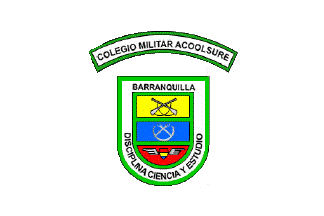
image by Ivan Sache, 3 January 2009
"Colegio Militar Acoolsure", a private cooperative institute, was founded in
Barranquilla on 19 October 1975 by Miguel Angel Sanchez Yepes, and recognized by
the Department of Atlántico in 1976 (Decree No 222). Its brand new grounds were
inaugurated by President of the Republic Julio Cesar Turbay on 8 December 1979.
The flag of the institute, as shown graphically on the
website of the institute, is white with the coat of arms of the institute in
the middle.
The coat of arms is made of a shield horizontally divided yellow-blue- red (the
Colombian national colours), surrounded by a white border bearing the black
writings "BARANQUILLA" (top) and "DISCIPLINA, CIENCIA Y ESTUDIO" (bottom, the
motto of the institute in Spanish, "Discipline, Science and Study"), and
surmounted by a white scroll charged with the name of the institute. All the
elements of the coat of arms are outlined in green.
The horizontal fields of the shield are charged with two crossed rifles proper,
two crossed anchors argent, and a shield vertically divided red-yellow-blue
flanked by two wings argent, respectively. The charges obviously represent the
Army, Navy and Air Force, respectively.
Ivan Sache, 3 January 2009
ACOOLSURE stands for Asociación Cooperativa Colombiana de Suboficiales en
Retiro del Ejército (Colombian Cooperative Association of Retired Army NCO's).
E.R., 3 January 2009
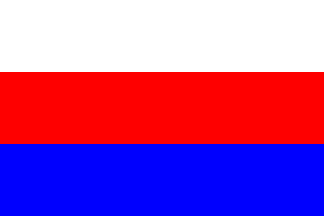 image by Ivan Sache, 18 October 2018
image by Ivan Sache, 18 October 2018
Colegio Militar Almirante Colón (COMIALCO) was established on 31 May 1986 in
Cartagena de Indias (Bolívar Department) by Jorge Isaac Correa Jiménez and
Elvira German German. A second seat was established in Cali (Valle del Cauca
Department) in 2002 by Fernando Rodriguez Betancourt.
The flag of
COMIALCO is horizontally divided white-red-blue.
http://comialco.edu.co/cartagena/side_menu/Nosotros/simbolos.html#
COMIALCO website
Ivan Sache, 18 October 2018
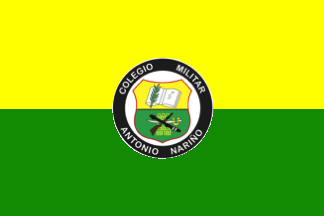 image by Ivan Sache, 30 December 2020
image by Ivan Sache, 30 December 2020
Colegio Militar Antonio Nariño (CMAN) was established in Suba (Bogotá) in
January 1972 by Major Pablo Emilio Pinillos Carrero (1915-1995).
The flag
of CMAN is horizontally divided yellow-green with the school's coat of arms in
the middle.
Photos
https://www.facebook.com/somoscman/posts/cuantos-recuerdan-este-momento/1573939802668329/
https://www.facebook.com/somoscman/photos/1356922297703415
https://www.facebook.com/somoscman/photos/1020420451353603
https://www.facebook.com/somoscman/photos/971366952925620
https://www.facebook.com/somoscman/photos/927679237294392
https://www.facebook.com/somoscman/photos/779045675491083
Yellow
represents the resources provided by knowledge acquired with the support of
writing.
Green represents hope to establish a new society.
The shield
is of Swiss shape, with a red bordure, the color of Infantry, in proportions
7:5.
The yellow, upper part features a book representing knowledge and a
quill representing the power of writing.
The lower, green part features the
emblems of Infantry, Cavalry, Artillery and Engineers, as components of the
National Army.
https://colegiomilitarantonionarino.edu.co/nosotros/heraldica/
School
website
Ivan Sache, 30 December 2020
 image by Ivan Sache, 30 December 2020
image by Ivan Sache, 30 December 2020
Colegio Militar Cooperativo Justiniano Quiñonez Angulo, located in Bogotá, is
named for Sergent Justiniano Quiñonez Angulo (1935-1998), Doctor in Medicine and
Surgery at the Pontificia Universidad Javeriana (1974), Professor of Chemistry
and Biology at Universidad Libre de Colombia and Dean of the Faculty of Sciences
of Education at Universidad Libre de Colombia.
The flag of Colegio
Militar Cooperativo Justiniano Quiñonez Angulo is plain green, 1.35 m x 1.10 m.
Green, the color of hope, represents the nation's great natural resources, the
greatness of natural environment, the institute's cooperativist philosophy, as
well a values of solidarity, friendship, excellence, deep faith and hope in Lord
Jesus Christ.
Ivan Sache, 30 December 2020
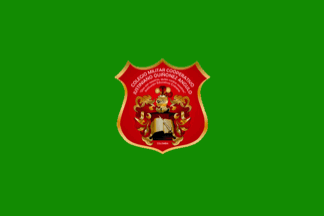 image by Ivan Sache, 30 December 2020
image by Ivan Sache, 30 December 2020
The standard of Colegio Militar Cooperativo Justiniano Quiñonez
Angulo is charged in the center with the school's coat of arms.
The coat of
arms, bordered in golden yellow, features the arms of the Quiñonez lineage,
which date back to the 11th century. The shield is surmounted by a helmet argent
with red and blue feathers, and surrounded by argent and red foliage. The shield
features an open Bible superimposed by a sword.
https://www.colegiomilitarjqa.edu.co/simbolos.html
School website
Photos
https://www.colegiomilitarjqa.edu.co/proceso-admisiones.html
https://docplayer.es/64082295-Colegio-militar-cooperativo-justiniano-quinonez-angulo-educamos-con-principios-cristianos-y-valores-solidarios-50-anos-plan-de-estudios.html
Ivan Sache, 30 December 2020
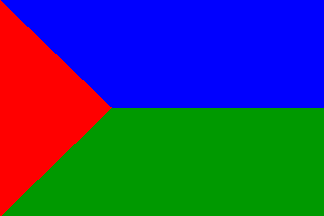 image by Ivan Sache, 19 July 2014
image by Ivan Sache, 19 July 2014
The flag of the institute, adopted in 1980, is horizontally divided
blue-green with a red triangle placed along the hoist.
Blue represents the rivers that surround the Boyacá Department.
Green represents the local landscape, as well as the integrity and the
courtesy of the institute's cadets.
The red triangle represents the blood shed by the Colombian heroes in
the Vargas Swamp and Boyacá Bridge battles.
The battle of the Vargas Swamp (Pantano de Vargas) was fought on 25
July 1819. The allied armies of Venezuela and New Granada (commanded
by Simón Bolívar), supported by British legions (commanded by James
Rooke), defeated the Spanish Royalist troops.
The battle of the Boyacá, fought on 7 August 1819, was the last,
decisive step to the independence of New Granada.
http://colegiomilitartunja.blogspot.fr/p/periodico-virtual-colegio-militar-tunja.html
Ivan Sache, 19 July 2014